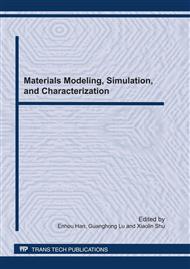p.24
p.29
p.33
p.39
p.43
p.49
p.58
p.64
p.69
Atomic Anti-Site Evolution during L12 Precipitation Using Microscopic Phase-Field Simulation
Abstract:
The influence of temperature on atomic site occupation probability (SOP) in L12--Ni3(Al1-xFex) has been studied using microscopic phase-field simulation for Ni3Al-Fe alloy with the lower Fe content. Microscopic phase-field kinetics model was further extended to study the temporal evolution of atomic site occupation and atomic anti-sites behavior, which was revealed in detail at the different temperatures. The results show that the size, number and the precipitation mechanism of L12 phases also present obvious changes with the increase of temperature. The SOP of each atom on its right-sites decreases slowly; while the SOP of Fe atoms are far lower than those of Al atoms. On the other hand, the SOP of each atom on its anti-sites increases gradually. The formation of NiAl (Ni atoms form anti-sites on Al sites) is more easily and the formation of NiAl is more sensitive to temperature than that of FeNi (Fe atoms form anti-sites on Ni sites). Atomic site occupation will not evolve during the early stage of precipitation, which becomes more and more obvious.
Info:
Periodical:
Pages:
43-48
Citation:
Online since:
June 2011
Authors:
Price:
Сopyright:
© 2011 Trans Tech Publications Ltd. All Rights Reserved
Share:
Citation:


